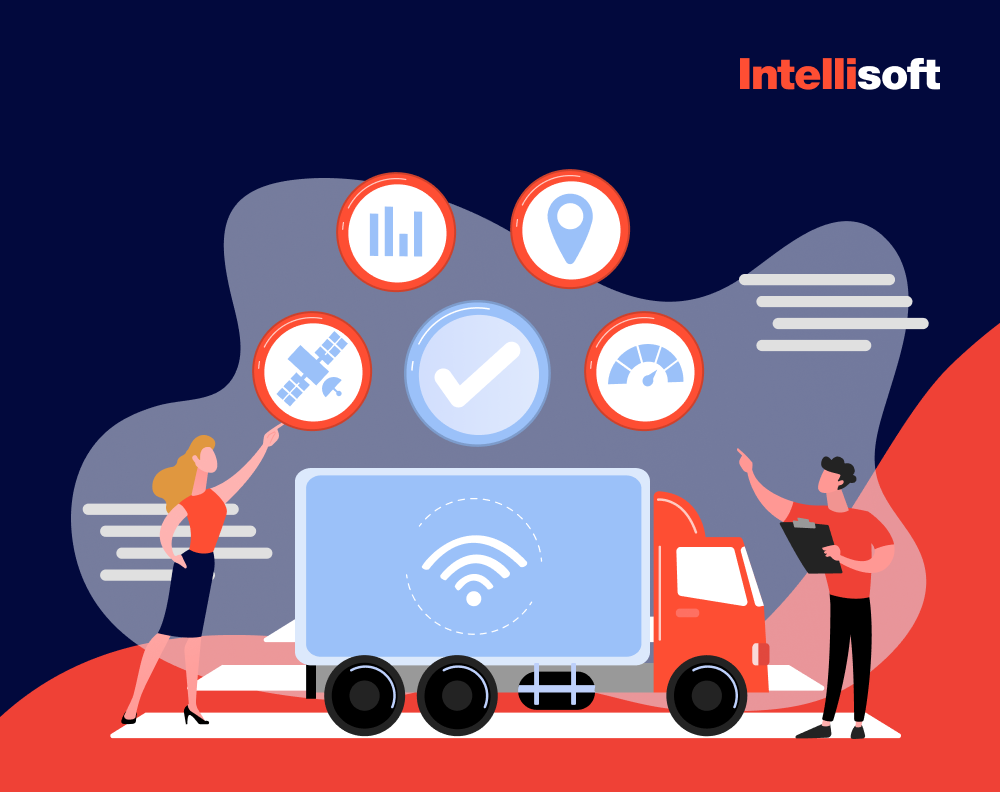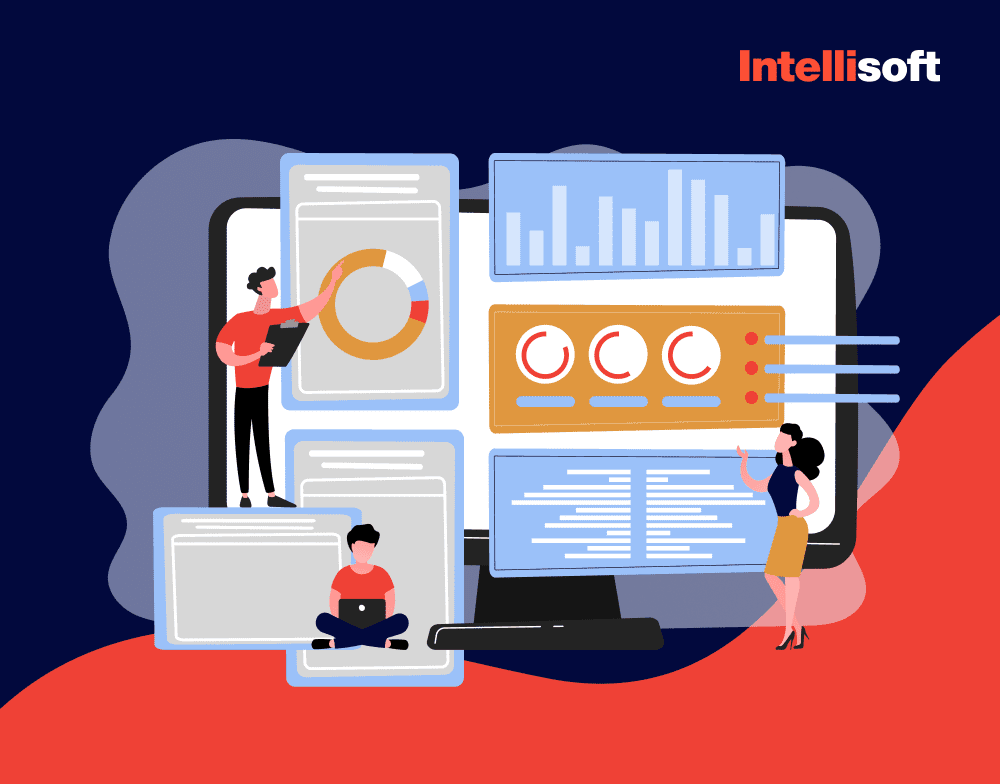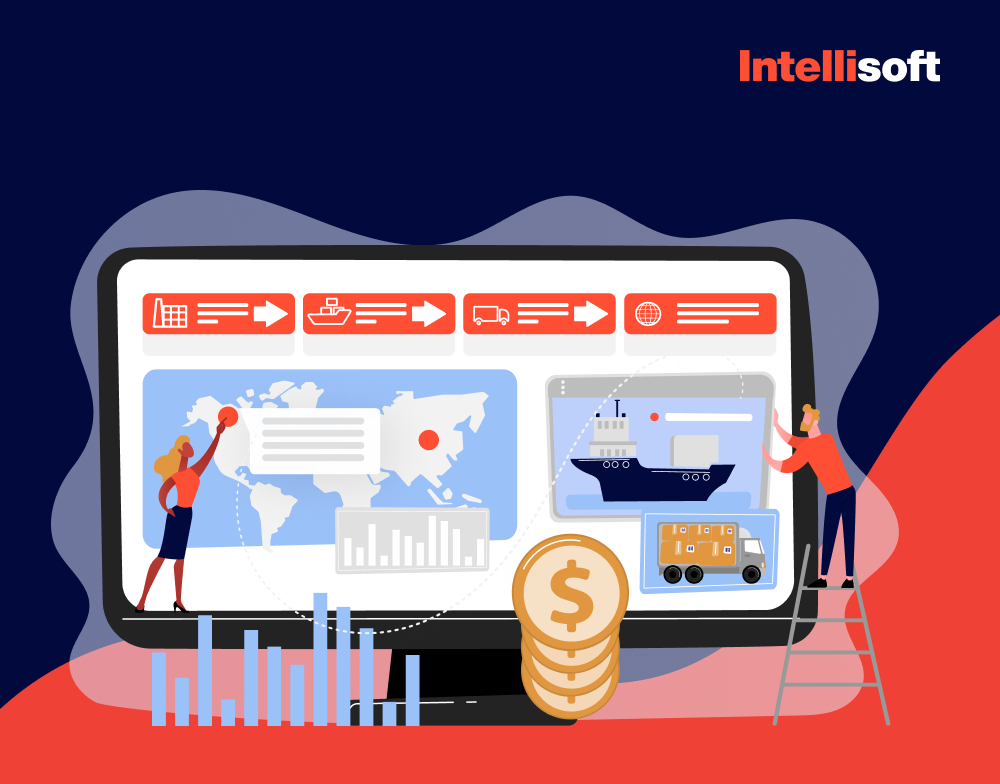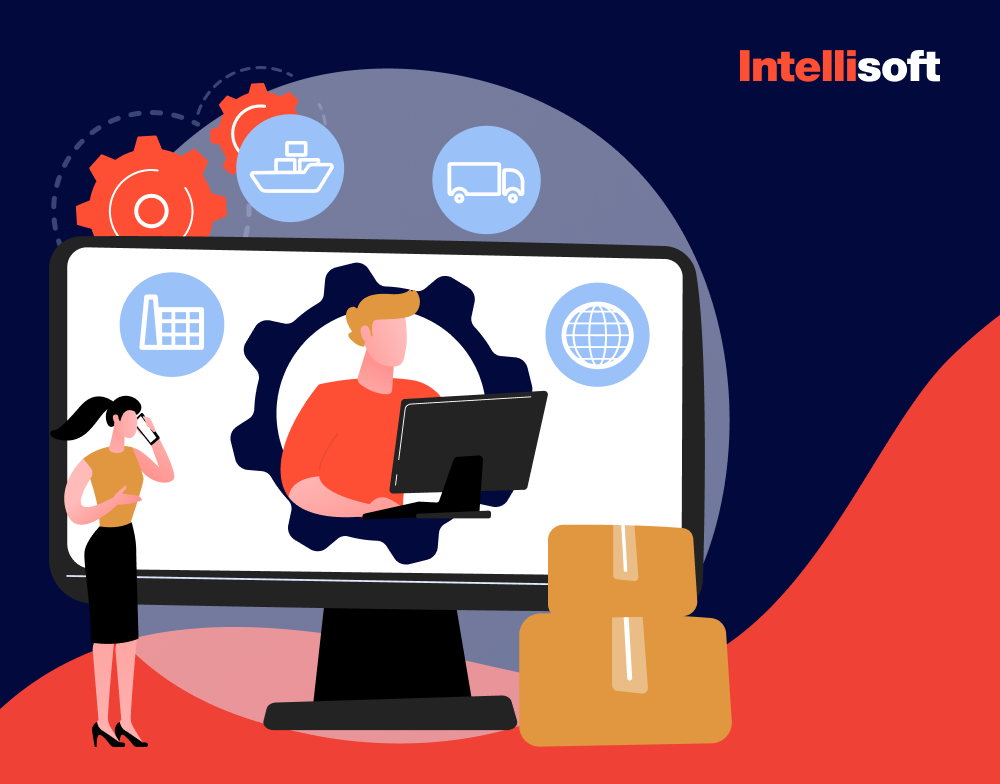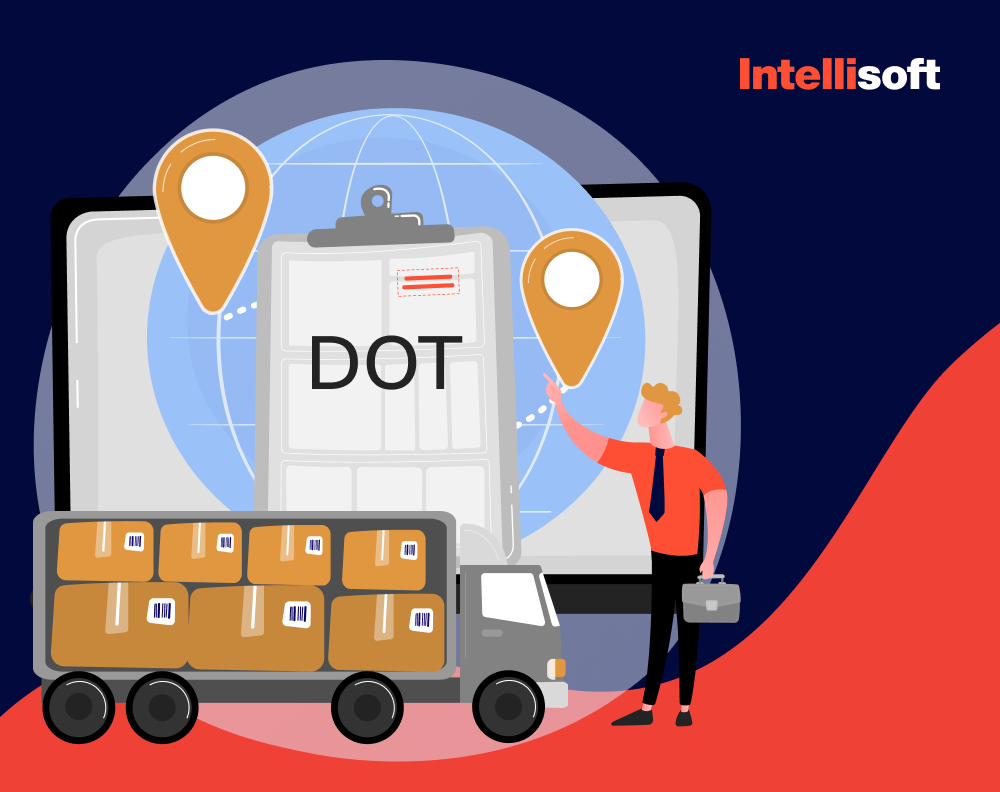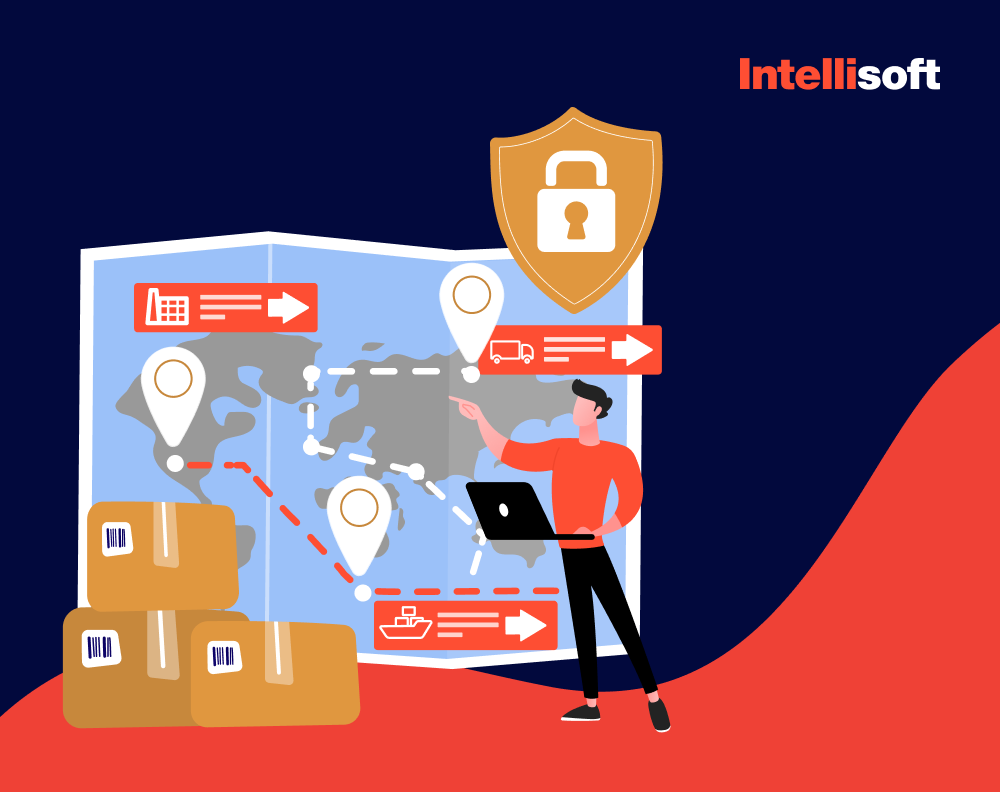Transportation is one of the main elements of the supply chain process. It might seem simple on the surface, but it comprises a lot of complex activities, including delivery planning, carrier management, shipment tracking, and others. All of these processes should be handled with care and management properly and streamlined to ensure efficient transportation. It’s no longer possible to manage all operations using spreadsheets and phone calls; it’s time to implement advanced functionality, automation, and digital transformation to elevate your business.
Transport management software is the solution you require to transform your business. At IntelliSoft, we have 13+ years of experience in the logistics industry, helping clients all over the world streamline their operations. Ingram Barge, a client from the USA, is one of our successful cases. We helped the marine transporter transfer all shipment management from Excel to the custom software we developed. If you have been looking for reliable TMS vendors to transform your transportation management, keep on reading.
Table of Contents
What is a Transport Management Software (TMS)?
A transportation management system, or a TMS, is a type of software that helps plan and execute the transportation of various goods. Transport management software can be used by all supply chain members – from manufacturers to distributors and even third-party logistics providers. Unlike traditional methods reliant on manual processes and fragmented systems, a TMS integrates seamlessly into existing infrastructures, offering a centralized platform for managing and coordinating various aspects of transportation.
Auto transport management software acts as the digital command center, facilitating the planning, execution, and monitoring of transportation activities with unparalleled precision. From route optimization and load planning to carrier selection and freight auditing, every task is streamlined and automated, empowering businesses to achieve newfound efficiency and cost-effectiveness.
TMS can also be seen as the control tower that captures data about goods in real time by using EDI or API technology. As a result, it provides users with valuable data from manufacturers to distribution centers and customers. Here’s an illustration of this process:
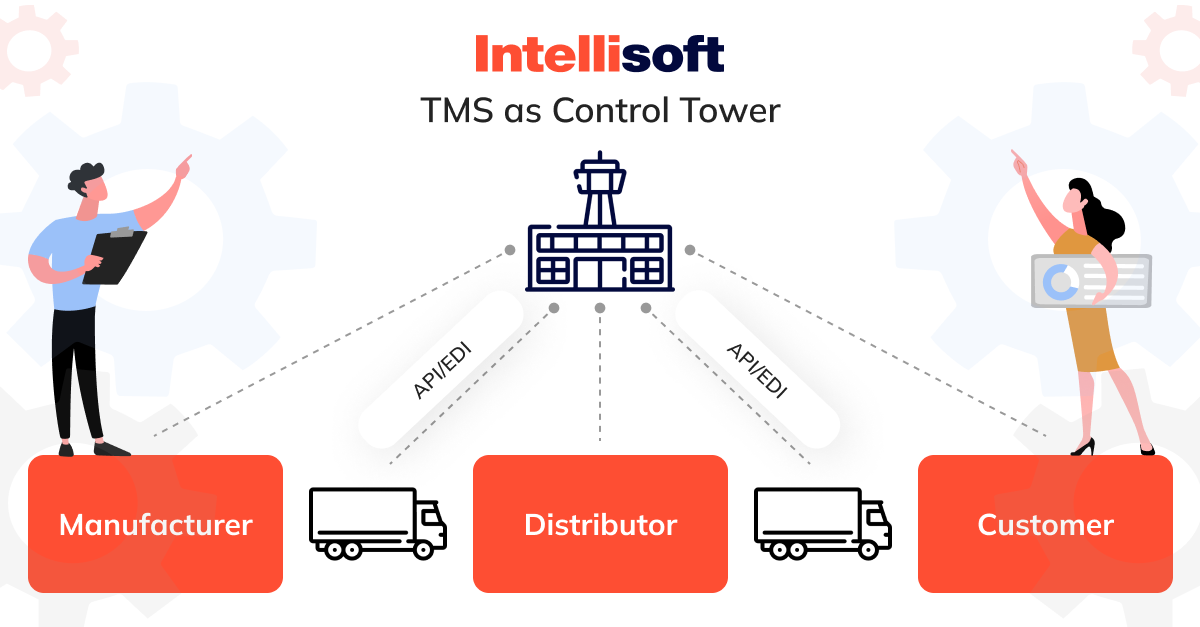
The two key user groups of a TMS are:
- Shippers, manufacturers, distributors
- Third-party logistics providers (3PLs)
Logistics transport management software allows the users to plan and execute their shipments and have complete visibility over them. This happens through various features that can be included in the software and integration of ERPs, LMSs, WMSs, and other tools. Here’s an illustration of this system:
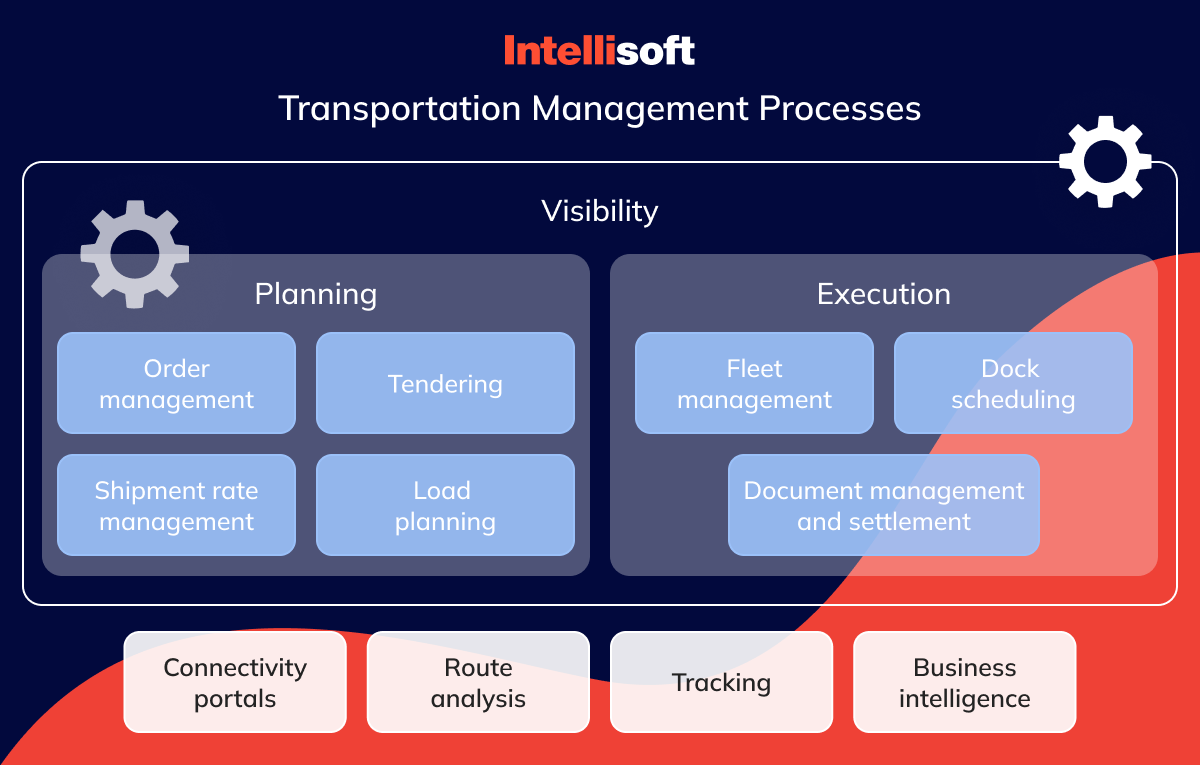
Benefits of Transport Management System Software
In the competitive landscape of modern logistics, embracing innovation is paramount to staying ahead. A Transportation Management System (TMS) stands as a beacon of efficiency, offering a myriad of benefits that transcend conventional approaches to transportation management. Let’s explore how a transport management software can revolutionize your operations and propel your business toward greater success.
Transportation management system benefits include:
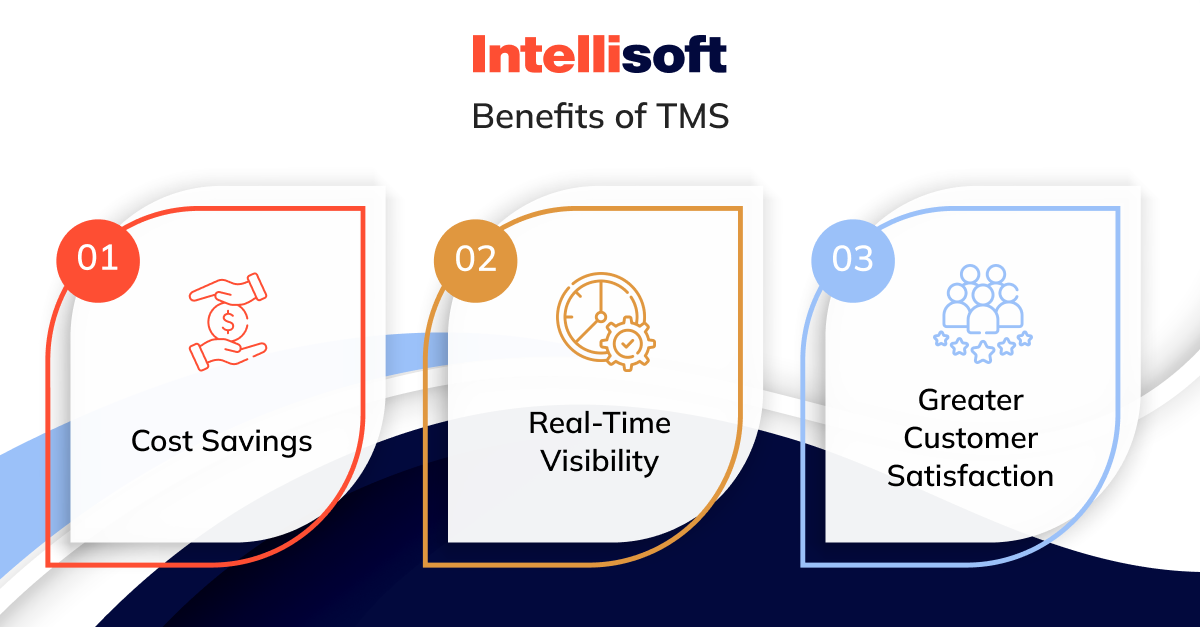
Cost Savings
Transport management system software saves costs significantly, both for the business and the customers.
First of all, it reduces administrative costs as a TMS makes it much easier to compare carrier rates and choose the best option. Transport management system software also automates the booking process, eliminating the need to make phone calls. By streamlining, integrating, and automating processes such as contract, auditing, payment, and scheduling, the software leads to improved efficiency, fewer errors, and saved costs.
TMS also saves money by lowering shipping costs. Employee transport management software minimizes transportation expenses while maximizing resource utilization by optimizing routes, consolidating shipments, and reducing empty miles. Through advanced algorithms and data-driven decision-making, businesses can identify the most efficient routes and modes of transportation, minimizing fuel consumption and transportation-related costs.
Real-Time Visibility
Software for transport management system provides businesses with unparalleled visibility into their transportation operations, enabling them to track shipments, monitor vehicle locations, and anticipate potential disruptions in real-time. Through integrated tracking and tracing functionalities, businesses can gain insights into the status and progress of each shipment from origin to destination.
As a result, companies can proactively address issues, minimize delays, and ensure seamless execution throughout the supply chain. Whether it’s responding to unexpected delays, rerouting shipments to avoid traffic congestion, or optimizing delivery schedules based on changing customer demands, a software for transport management system empowers businesses to make informed decisions and take proactive measures to enhance operational efficiency and customer satisfaction.
Greater Customer Satisfaction
One of the main benefits of employee transport management software is its ability to improve customer satisfaction – a key to staying competitive in the market. Customer satisfaction is achieved by enabling faster delivery times, accurate order tracking, and superior service levels.
Moreover, the real-time visibility provided by employee transport management software allows businesses to keep customers informed throughout the transportation process, providing updates on shipment status, estimated arrival times, and any potential delays. This proactive communication not only builds trust and confidence, but also allows businesses to address any concerns or issues in a timely manner, further enhancing the overall customer experience.
Related articles:
- How to Develop Logistics Management System: Timeframe, Tech Stack, and Costs
- Machine Learning in Logistics Industry: Benefits and Use Cases
- How Predictive Analytics Solutions Are Benefitting Supply Chain
- The Ultimate Blueprint for Building a Successful Packers and Movers App
- Warehouse Automation Systems: Revolutionizing Supply Chains for Unprecedented Efficiency
Transportation Planning Features
The transportation process is initiated by generating a transport request, including a quote and comprehensive shipment details. Shippers then tender loads to carriers, who undertake the responsibility of capacity planning and cargo distribution.
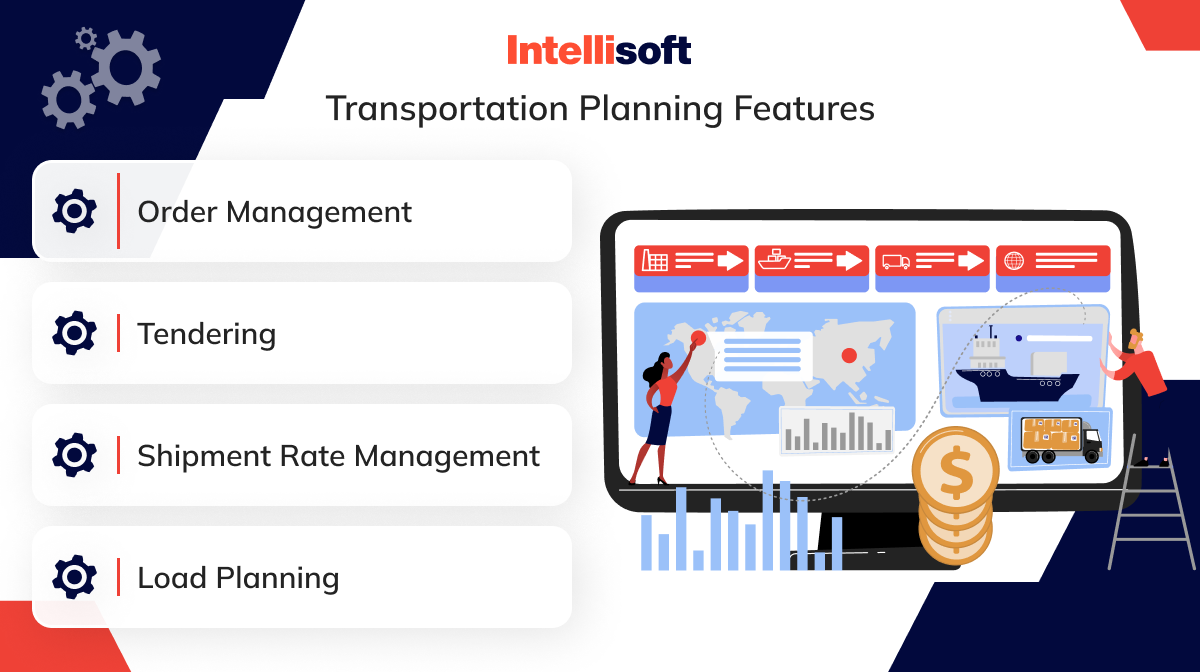
Order Management
Within transport fleet management software, order information is accessible to all relevant parties, ranging from planners to drivers and customers. Here are the features that facilitate users in viewing and managing transport requests:
- Order Entry. Whether performed manually or automatically, order entry involves inputting all necessary details, such as commodity type, weight, and specifying the current location and destination. The system often generates a route automatically, assigns transportation and drivers, and calculates the estimated time of arrival (ETA). If integrated with a Warehouse Management System (WMS), the order seamlessly transitions to its scheduled transport.
- Order Overview. Orders, along with their respective routes and assigned transports, are readily available to order planners and drivers via a dashboard interface. This dashboard provides a comprehensive view of their workload for the day. All relevant documents are automatically linked to their corresponding orders, allowing drivers to access them conveniently on their smartphones or tablets. As drivers update the status of orders en route, planners gain visibility into all scheduling changes and the current locations of trucks.
Tendering
Tendering in most transport fleet management software is automated, and shipment requests are handled on your behalf. Carriers are listed based on your specific preferences, or the system can select a carrier for you. Different tendering methods are available, including broadcast, waterfall, and status tendering.
Various tendering strategies exist within TMSs:
- Least-cost. Selects the lowest rate and extends the offer to other carriers.
- Auto-award. Automatically assigns shipments to specific carriers.
- Allocations. Allocates shipments based on contractual percentages or load numbers (e.g., 4 loads to Carrier A and 3 loads to Carrier B).
- Service-based. Chooses the best-performing carrier.
- Customer-based. Selects the carrier preferred by the customer.
Shipment Rate Management
Shipment Rate Management in a transport fleet management software is about handling freight rates. It includes setting, maintaining, and applying rates for different shipping services. This helps businesses keep track of costs and negotiate better deals with carriers.
With features like rate configuration and comparison, a TMS helps businesses find the best rates and save money on shipping.
Load Planning
Load planning is a crucial aspect of transportation management that involves strategically arranging goods or freight within vehicles to maximize space utilization, minimize transportation costs, and ensure the safe and efficient transport of goods.
Within a Transportation Management System (TMS), load planning features enable businesses to optimize the loading of vehicles based on factors such as weight distribution, cargo dimensions, and delivery schedules. These features leverage algorithms and optimization techniques to generate efficient loading plans that minimize empty space and reduce the number of vehicles required for transportation.
Transportation Execution Features
After the shipper and carrier reach an agreement, the actual transportation of the load begins. While a transport management software online cannot physically deliver freight, it plays a vital role in facilitating fleet management, dock scheduling, and settlement processes, easing operational burdens.
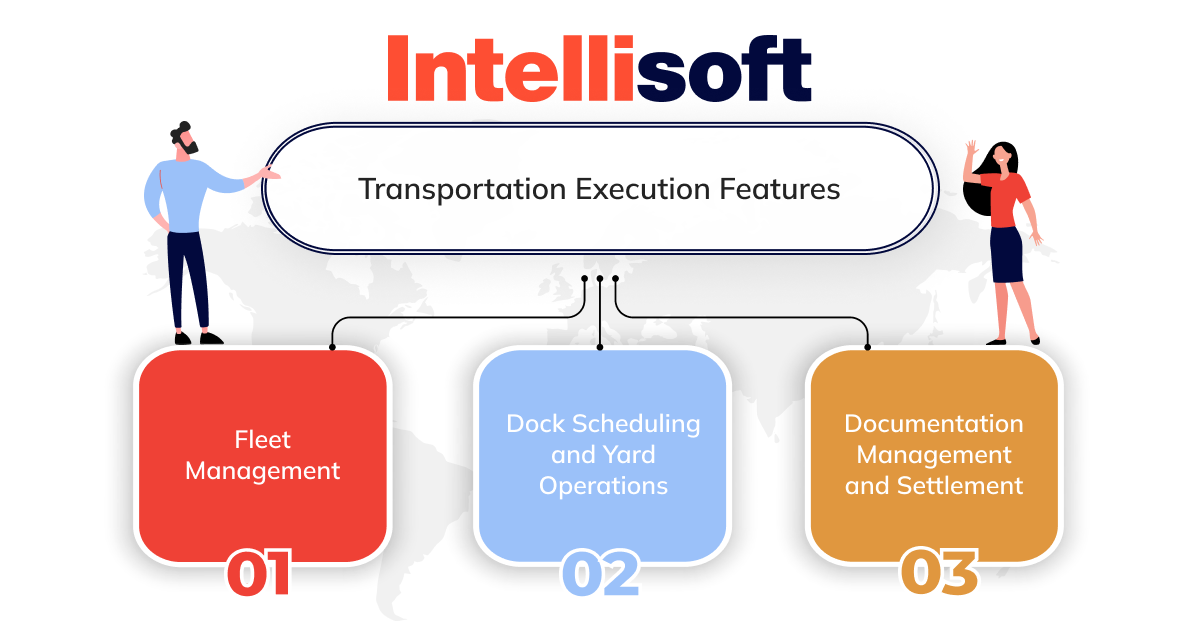
Fleet Management
A TMS provides a centralized platform for businesses operating their fleet to visualize and utilize assets efficiently. While not all TMS providers offer advanced fleet management features, functionalities typically include driver and equipment assignment, dispatch management, and financial settlement for drivers.
Advanced fleet management software can also manage fuel consumption, monitor environmental impact, track vehicle maintenance, and enable remote truck control, enhancing operational efficiency and cost-effectiveness.
Dock Scheduling and Yard Operations
Efficient management of dock scheduling and yard operations is critical for optimizing throughput and minimizing dwell times in logistics operations. The best transport management software streamlines the coordination of loading and unloading activities, ensuring that resources are allocated effectively and trucks spend minimal time idling at docks. Features such as appointment scheduling, yard management, and dock door optimization enhance operational efficiency, reduce congestion, and improve overall workflow productivity.
Documentation Management and Settlement
Accurate documentation management and timely settlement processes are paramount for maintaining transparency and financial integrity in transportation operations. A TMS facilitates the creation, storage, and retrieval of essential documents such as bills of lading, proof of delivery, and invoicing records.
The TMS expedites the settlement process, streamlines billing reconciliation, and reduces administrative overhead by automating document workflows and integrating with accounting systems.
Moreover, comprehensive reporting capabilities provide stakeholders with visibility into financial transactions and facilitate audit compliance, ensuring that all parties involved are appropriately compensated and that financial records are accurately maintained.
Transportation Visibility Features
Now that your shipment has been delivered, the journey still doesn’t end here. You need to find a way to connect to your partners to support your business relationships and analyze all operations to make more data-driven decisions about future operations.

Connectivity Portals
Transportation management systems support connecting to partners and customers via email, but creating a customizable self-service portal is possible. Using this portal, customers can create and verify their orders’ status, and partners can send tender offers and review their invoices.
Route Analysis
A TMS equipped with route analysis capabilities utilizes historical data, real-time traffic information, and geographical insights to evaluate the performance of existing routes and identify opportunities for improvement. Businesses can make informed decisions about route modifications, mode selection, and resource allocation by analyzing factors such as delivery times, fuel consumption, and driver productivity, ultimately enhancing overall operational effectiveness and customer satisfaction.
Tracking, Tracing, and Event Management with Telematics and RFID
Tracking, tracing, and event management are the three main components of transportation visibility. They are united and powered by cutting-edge technologies such as telematics and Radio Frequency Indentifican (RFID). These functionalities provide real-time visibility into the intricate movements and status updates of shipments in the supply chain. Telematics devices embedded within vehicles serve as the nerve center, relaying crucial data encompassing location, velocity, and vehicle diagnostics. Meanwhile, the strategic deployment of RFID tags on pallets or containers ensures seamless tracking from warehouse inception to final destination.
Business Intelligence and Analytics
Business Intelligence is about improving business results using data. One of the main advantages of BI is the real-time analytics and various custom reports that anyone from your team can generate at any time. Harnessing the power of business intelligence and analytics fosters a data-driven approach to logistics management, enabling organizations to optimize resources, mitigate risks, and capitalize on emerging opportunities.
TMS Integrations
Transport management software is usually a part of a company’s IT ecosystem, so it should be seamlessly connected to other company’s systems. Here is what you can integrate your TMS with:

ERP
An ERP controls all business processes and is at the core of the company’s IT infrastructure. It helps control manufacturing, sales, finance, transportation, and marketing. If you have an ERP platform, integrate it with a TMS to exchange order details and plan transportation activities.
Warehouse Management System
Using a WMS and connecting it to a TMS will help you coordinate your warehousing and shipping operations, share information, and schedule loading and unloading processes.
Order Management/Inventory Management Solutions
Integrating your TMS with order management or inventory management solutions streamlines order and inventory management. This ensures accurate data sharing and efficient scheduling of transportation activities.
Accounting/Settlement Tools
Integrating your TMS with accounting tools can automate billing, invoicing, and settlement processes, enhance financial transparency, and streamline transaction management.
Business Intelligence
Gain valuable insights from transportation data by integrating your TMS with Business Intelligence platforms. Analyze performance metrics and make data-driven decisions to optimize operations.
External Carrier or 3PL System
You can communicate with your partners with the help of a self-service portal or create integration with a TMS to exchange transportation information quickly. Streamline communication and coordination to ensure smooth transportation processes and enhance overall supply chain performance.
Freight Marketplaces
Integrating your TMS with freight marketplaces allows you to access a wider network of carriers and optimize transportation options. You can also quickly source capacity and find cost-effective transportation solutions to meet your shipping needs efficiently.
What Options Do You Have?
Ready to start automating your transport management processes? You have three key options; to buy an on-premises TMS, to use a cloud-based one, or to invest in the development of a custom TMS.
Buy an On-Premises TMS
This version was the most popular in the past, but it lost its appeal when cloud-based versions entered the market. On-premises TMS solutions are installed by TMS vendors on your hardware and run locally. They are installed by a hosted TMS provider who installs the software at your company’s main office.
Let’s analyze the benefits and drawbacks of this type of TMS:
Security
This option gives you control over your data, and third parties can’t access it. The in-house team has access to and knowledge of the system and data. However, since all data is stored locally, a disaster can result in complete data loss if the data isn’t protected properly.
Functionality
On-premises software offers features for a fixed price; however, the functionality may be excessive, making the product too complex. The highly customizable nature of the software may also lead to support issues that can only be handled by outside experts from the company providing the software.
Scalability
On-premises TMS solutions provide greater control over scalability compared to cloud-based solutions. However, scaling may require additional investment in hardware and IT resources, and it may be limited compared to the elastic scalability of cloud-based solutions.
Data Exchange
With an on-premises TMS, you have full control over data exchange processes between internal and external systems. Integration with legacy systems may be simpler due to direct access to local data. However, integration with external partners or cloud-based systems may be more challenging, and real-time data exchange may be limited.
Cost
While on-premises TMS solutions eliminate recurring subscription fees associated with cloud-based solutions, they require a higher initial investment in hardware, software licenses, and implementation services. Additionally, ongoing maintenance and support costs may be higher compared to cloud-based solutions.
Use Cloud Based Transport Management Software
There are numerous TMS solutions hosted in the cloud that offer great functionality.
Security Measures
Cloud-based TMS solutions bolster security through robust features like encrypted data storage, frequent backups, and multi-factor authentication protocols. Information is safeguarded within fortified data centers, boasting stringent access controls and compliance certifications. Nonetheless, apprehensions surrounding data privacy and reliance on third-party security measures may surface, warranting careful consideration.
Functional Capabilities
Cloud-based TMS solutions showcase an extensive array of functionalities accessible from any location with internet connectivity. They often offer seamless updates and feature enhancements sans additional hardware or software installations. Yet, the plethora of features may introduce complexity, necessitating user training and potentially leading to underutilization of capabilities.
Scalability
One of the key advantages of cloud-based TMS solutions is scalability. Businesses can easily scale their usage up or down based on changing needs without significant investment in infrastructure. This scalability allows for flexibility in accommodating growth and seasonal fluctuations in transportation volumes. However, businesses may face challenges in managing costs as usage scales up, especially if pricing is based on usage metrics.
Data Exchange
Through APIs and integrations, cloud-based TMS solutions facilitate seamless data exchange between internal and external systems. They offer real-time visibility into transportation data, enabling better decision-making and partner collaboration. However, concerns about data interoperability and potential disruptions in connectivity may arise, particularly in areas with limited internet access.
Cost
Cloud-based TMS solutions typically operate on a subscription-based pricing model, offering lower upfront costs compared to on-premises solutions. Businesses pay only for the resources and features they use, making it easier to manage costs and scale as needed. However, over time, subscription fees may accumulate, and businesses may face challenges in predicting and controlling long-term costs.
Custom Logistics App Development
There are a lot of options for ready-made TMS solutions, yet many businesses still opt for developing custom software solutions instead of using what’s available on the market. Why would businesses develop custom solutions if ready-made tools are cheaper and easier to use? Let’s explore the benefits of custom TMS solutions:
Security
You are the owner of your custom TMS, which means that no third parties can access your data. Thus, make sure that you cooperate with a trusted and experienced technical partner who will be responsible for the security of your solution and protect data from breaches and attacks.
Functionality
Functionality is at the core of transportation management system development. This allows you to select the specific features you require, crafting a straightforward interface complete with built-in onboarding and helpful hints. Should you wish to expand your capabilities, simply reach out to your technology provider to incorporate new modules seamlessly into your current solution.
Scalability
Once you decide to build a custom TMS, make sure that you highlight its scalability. Scalability should be incorporated into the architecture of your solution from the very start, or it will be impossible to scale it later. Again, your tech partner should take care of this matter.
Data Integration
Crafting transportation management software equipped with tailored APIs facilitates smooth data interchange in a standardized format among various stakeholders, including warehouse management systems, enterprise resource planning tools, and other pertinent software solutions within your organizational framework.
Cost Considerations
Investing in custom Transportation Management Systems (TMS) necessitates a higher initial outlay compared to monthly subscription fees. However, this upfront investment promises long-term savings, eliminating recurrent monthly expenditures. The total cost varies based on specific feature requisites, chosen tech collaborator, and the intricacy of the solution tailored to your business needs.
How Much Does It Cost to Develop a TMS?
The cost of developing a custom transport management software online depends on multiple factors; whether you are planning to expand or differentiate the business, how complex the solution will be, what features it will include, where the development is from, and so on.
For contemporary TMS solutions, key components typically encompass an administrative panel for managerial duties, digital assistants, GIS functionalities, driver-dispatcher communications, and integrated accounting systems. Based on this foundational functionality, the estimated cost for the entire development cycle averages around $200,000. However, it’s essential to recognize that this price point may fluctuate depending on the specific features tailored to meet your business needs.
Conclusion
As the demand for seamless transportation solutions continues to grow, investing in developing a tailored TMS emerges as a competitive advantage and a strategic imperative. The best transport management software is a custom TMS; it will allow you to streamline your processes, meet the ever-changing customer demands, and stay competitive in the market.
At Intellisoft, we understand the intricacies of TMS development and are committed to delivering cutting-edge solutions that empower businesses to navigate global commerce’s complexities confidently. With our expertise in custom software development and dedication to client satisfaction, we stand ready to transform your transportation management challenges into opportunities for growth and success.
Take the first step towards optimizing your logistics operations today. Contact Intellisoft to explore how our innovative TMS solutions can revolutionize your business and propel you toward greater efficiency and profitability.


